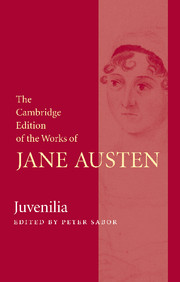Book contents
- Frontmatter
- Contents
- General editor’s preface
- Acknowledgements
- Chronology
- Introduction
- Note on the text
- Volume the First
- Volume the Second
- Volume the Third
- Corrections and emendations
- Appendix A The History of England: facsimile
- Appendix B Marginalia in Oliver Goldsmith’s The History of England, from the Earliest Times to the Death of George II
- Appendix C Marginalia in Vicesimus Knox’s Elegant Extracts . . . in Prose
- Appendix D Sophia Sentiment’s letter in The Loiterer, 28 March 1789
- Appendix E Continuations of ‘Evelyn’ and ‘Catharine’ by James Edward Austen and Anna Lefroy
- Abbreviations
- Explanatory Notes
Appendix E - Continuations of ‘Evelyn’ and ‘Catharine’ by James Edward Austen and Anna Lefroy
Published online by Cambridge University Press: 18 December 2020
- Frontmatter
- Contents
- General editor’s preface
- Acknowledgements
- Chronology
- Introduction
- Note on the text
- Volume the First
- Volume the Second
- Volume the Third
- Corrections and emendations
- Appendix A The History of England: facsimile
- Appendix B Marginalia in Oliver Goldsmith’s The History of England, from the Earliest Times to the Death of George II
- Appendix C Marginalia in Vicesimus Knox’s Elegant Extracts . . . in Prose
- Appendix D Sophia Sentiment’s letter in The Loiterer, 28 March 1789
- Appendix E Continuations of ‘Evelyn’ and ‘Catharine’ by James Edward Austen and Anna Lefroy
- Abbreviations
- Explanatory Notes
Summary
The two items in ‘Volume the Third’, ‘Evelyn’ and ‘Catharine’, written in 1792, were both left unfinished at that time. Jane Austen provided page numbers for ‘Evelyn’ up to 21, ending near the top of that page with the words ‘full gallop all the way’. She began paginating again with number 31, the second page of ‘Catharine’, thus leaving nine blank pages in which ‘Evelyn’ could be completed. It was eventually finished, but not by Austen herself: the last few pages, written with a different pen and ink (number 1 below), are in the hand of James Edward Austen (1798–1874), the son of Austen’s brother James, who changed his name to Austen-Leigh in 1837. He filled the rest of page 21 and pages 22 to 27 (without numbering them): pages 28 and 29 remained blank. ‘Catharine’, which occupies pages 30 to 127 of ‘Volume the Third’, was also left incomplete by its author. Austen's text ends at the foot of her page 124, with the words ‘conduct of Young Men’. The story is continued on pages 125–7, also by James Edward Austen, but this continuation is in itself incomplete.
Further complicating the textual issues of ‘Volume the Third’ is a four-page continuation of ‘Evelyn’, written on separate leaves of paper loosely inserted in the volume. This continuation (number 2 below), in the hand of Jane's niece Anna (1793–1872), also the daughter of James Austen and the half-sister of James Edward Austen, is initialled ‘JAEL’, the letters standing for her married name, Jane Anna Elizabeth Lefroy. Since Anna married Benjamin Lefroy in November 1814, she must have initialled her continuation either at the end of that year or later. On 25 December 1814, Anna’s grandmother, Cassandra Austen ( Jane's mother), wrote her a letter, expressing concern that the young writer ‘must be quite bewildered by composing two works at the same time’. As Kathryn Sutherland contends, the two works are probably Anna's novel-in-progress, ‘Which is the Heroine?’ (never completed and later destroyed), and her continuation-in-progress, ‘Evelyn’, which breaks off abruptly without much advancing the story. The parody of the Gothic in Anna's attempted completion of ‘Evelyn’ seems indebted to that in Northanger Abbey, which Austen was revising at the end of her life and which she could have discussed with her literary niece at that time.
- Type
- Chapter
- Information
- Juvenilia , pp. 363 - 370Publisher: Cambridge University PressPrint publication year: 2006



